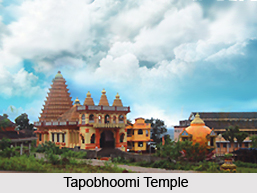 Tapobhoomi Temple at Kundaim in Goa is a centre of Param Pujya Padmanabh Shishya Sampradaya. The temple is spread over an area of 10,000 sq. metres. The temple was built under the divine inspiration of his Holiness Haturii Mathadhish Shrinad Brahmanand Swamiji. The temple has now become a pilgrimage centre for many students of Hindu culture and religion. This centre harbours a number of projects like the unique Datta mandir, Sanskrit pathshala, Dhyaan Gumfa (Chamber for meditation), Ayurveda Centre, Yoga Anusandhan Kendra, Bhajani Vidyalayi Bhaktoddhar Library, and others.
Tapobhoomi Temple at Kundaim in Goa is a centre of Param Pujya Padmanabh Shishya Sampradaya. The temple is spread over an area of 10,000 sq. metres. The temple was built under the divine inspiration of his Holiness Haturii Mathadhish Shrinad Brahmanand Swamiji. The temple has now become a pilgrimage centre for many students of Hindu culture and religion. This centre harbours a number of projects like the unique Datta mandir, Sanskrit pathshala, Dhyaan Gumfa (Chamber for meditation), Ayurveda Centre, Yoga Anusandhan Kendra, Bhajani Vidyalayi Bhaktoddhar Library, and others.
His Holiness Brahmanand Swamiji, who is the head of Haturii Muth has rendered immense service for the upliftment of the poor and the downtrodden people in the last two decades. While propagating the Bhakti movement in this holy land, he has rescued many people from falling into the clutches of vices such as drinking, gambling, drug-abuse etc. It is solely under Swamiji`s guidance that thousands of young people have been able to choose the correct path of life and follow it.
Tapobhoomi has been set up to educate mankind about its duties and responsibilities of life. It seeks to extend the message of divine love and compassion. Tapobhoomi is indeed a temple of humanity, standing firm on the foundation of devotion i.e. Bhakti.
This article is a stub. You can enrich by adding more information to it. Send your Write Up to content@indianetzone.com





















